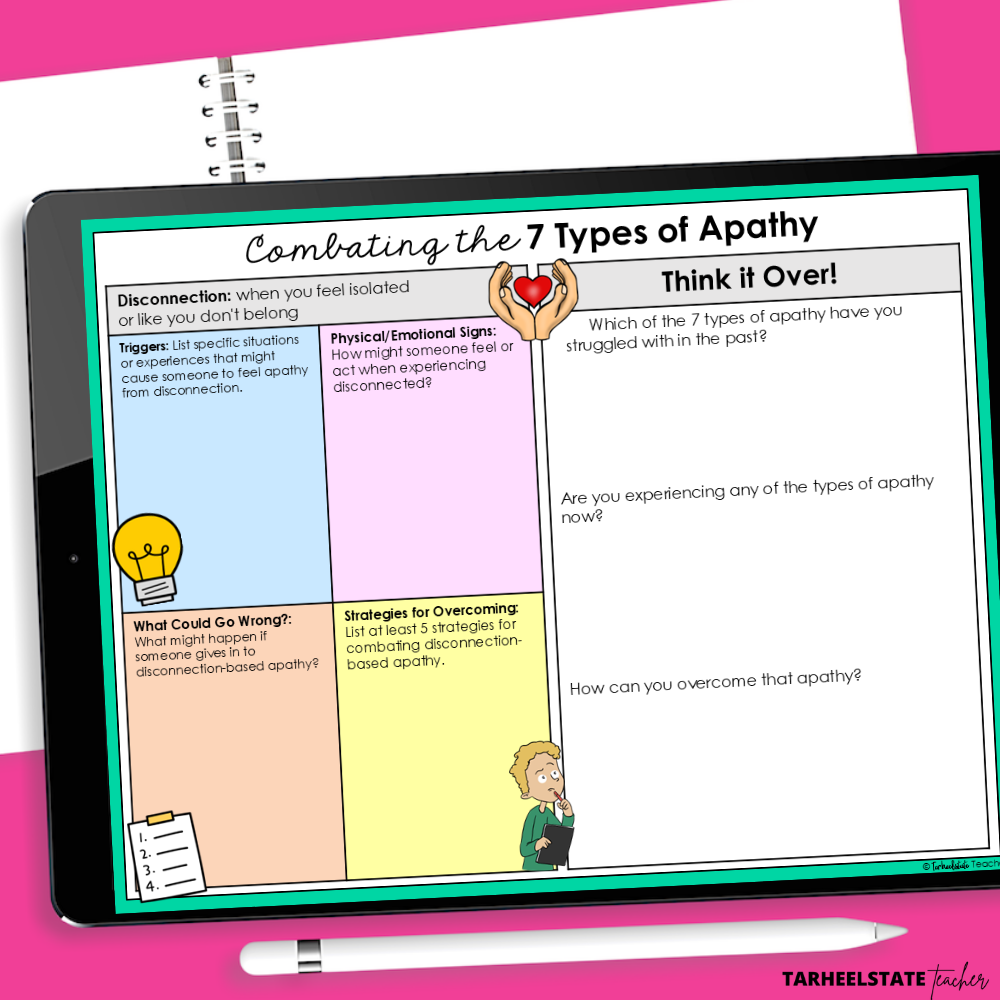How to Overcome Apathy in Students and Reignite Motivation
As teachers, we’ve all seen it — the blank stare, the slumped posture, the student who shrugs and says, “I don’t care.” Apathy in students can be one of the most frustrating challenges in the classroom. It’s not just about missing work or low energy — it’s the sense that some students have given up before they’ve even begun. And if left unaddressed, apathy can spread like wildfire, dulling even the most engaging lesson plans.
So how do we as teachers confront this head-on? How do we go beyond surface-level compliance and reignite students’ inner spark? It starts by understanding what apathy really is — and then teaching students the tools and support they need to push through it.
WHAT IS MEANT BY APATHY?
Apathy is more than just laziness or indifference. It’s a lack of motivation, interest, or emotional investment — a feeling that effort doesn’t matter, or that nothing will change even if it’s given.
In school, student apathy might look like incomplete assignments, low participation, or emotionally flat reactions to praise or feedback.
Many students won’t say “I feel apathetic,” but they will say things like:
“What’s the point?”
“It doesn’t matter.”
“I don’t care.”
These comments are signs of deeper disconnection — and that’s something teachers can work to address.
WHAT CAUSES APATHY IN STUDENTS?
Understanding why students shut down is key to helping them re-engage. Student apathy in the classroom often stems from one or more of the following causes:
Lack of Interest – They simply don’t connect with the topic.
Feeling Overwhelmed – Too much work or unclear expectations can lead to avoidance.
Fear of Failure – Rather than risk being wrong, some students would rather not try at all.
Lack of Purpose – They don’t see the value or real-life connection of what they’re learning.
Low Confidence – Past struggles can erode belief in their own abilities.
Boredom – Tasks that are too easy or repetitive can feel pointless.
Disconnection – Students may feel isolated from their peers, teacher, or school community.
Identifying the root cause allows teachers to respond with intention, not just intervention.
HOW TO COMBAT APATHY IN STUDENTS
Once we know what we’re dealing with, the next step is to rebuild connection, confidence, and momentum. These strategies not only address apathy in schools but also help promote intrinsic motivation in students — that internal drive that keeps them moving even when things are tough.
1) START WITH STUDENT REFLECTION
Before jumping into solutions, help students recognize what apathy feels like. One of my favorite activities involves brainstorming signs of motivation vs. signs of apathy. It opens the door for students to reflect on their own patterns and consider what might be getting in their way.
💡Try this: Use a “Spot the Signs” journal page where students write down when they feel most engaged and when they tend to check out. This helps them name the behavior — a crucial first step.
2) BREAK IT DOWN: IDENTIFY THE CAUSE
Have students explore the seven most common causes of apathy using a student-friendly chart or anchor display. Once they understand the “why,” it becomes easier to brainstorm the “what now.”
💡Try this: Assign small groups one root cause (like fear of failure or boredom) and have them brainstorm solutions. Then do a gallery walk so everyone gets to learn all the strategies. This gives students ownership over the process.
3) FOCUS ON SMALL WINS
Motivation in the classroom often returns one success at a time. Celebrate effort, not just outcomes. Students who feel like they “can’t do anything right” need opportunities to prove to themselves that they can.
💡Try this: Encourage students to choose one specific cause of apathy they struggle with most. Then, have them brainstorm five personal strategies they could try to overcome it. These lists become a go-to resource when they’re feeling stuck.
4) CREATE SAFE SPACES FOR SHARING
Sometimes, students just need to feel heard. Building peer-to-peer empathy through discussion helps normalize the ups and downs of motivation.
💡Try this: Use advice-column-style writing prompts, like “Dear Spark,” where students respond to fictional letters from peers who feel unmotivated. This creates a low-pressure, reflective way to talk about big feelings and offer support.
5) USE SCENARIOS TO BUILD PROBLEM-SOLVING SKILLS
Instead of lecturing students about effort, give them scenarios where they can analyze what’s going on and decide what could help.
💡Try this: Present short apathy scenarios and have students work in groups to identify possible causes and solutions. They’ll begin to see patterns and realize they can change their approach.
6) ALLOW FOR CHOICE AND VOICE
Building intrinsic motivation in the classroom starts with autonomy. Students are far more likely to engage when they feel they have some control over how they show what they know.
💡Try this: Offer low-stakes choice boards, flexible formats for assignments, or opt-in discussion strategies like think-pair-share. For students who feel overwhelmed or disconnected, options reduce pressure and rebuild confidence.
When students feel heard and respected, they become more open to exploring the why behind their lack of motivation. That’s where meaningful reflection comes in. To help students better understand their own apathy—and start to move through it—it can be helpful to have guided tools and structured activities on hand.
NEED MORE MOTIVATION ACTIVITIES AND DONE-FOR-YOU RESOURCES FOR COMBATING APATHY?
My Intrinsic Motivation SEL Unit is designed to support students as they identify what apathy looks like, uncover its root causes, and take small but powerful steps toward re-engaging and giving students ownership over their learning journey. The unit includes suggested books about motivation for read alouds, interactive lessons, motivation activities, discussion questions, quotations about motivation (in journal and poster form), and a personal motivation self-assessment. Student journal pages highlight activities like examining what causes apathy, combating the 7 types of apathy, intrinsic vs. extrinsic motivation sort, situations that test our motivation scenario cards, identifying motivators and demotivators, brainstorming times when extrinsic motivation works best, the power of self-talk brainstorming exercise, spotting the signs of apathy, thinking through overcoming apathy scenarios, and more!
SOCIAL-EMOTIONAL TOPICS TO GUIDE YOUR MORNING MEETINGS ALL YEAR
If you’re looking to increase your social-emotional learning focus, you’ve come to the right place my friend! This Intrinsic Motivation themed SEL unit is also included in the SEL Morning Meeting MEGA Bundle that contains 16 social- emotional learning themes. With units focused on gratitude, empathy and compassion, growth mindset, conflict resolution and compromise, grit and perseverance, responsibility, understanding and managing emotions, and so much more, your engaging SEL or morning meeting plans are done for you and your students will love them!
If you purchase the bundle from my personal website store, you can save 20% on the SEL Mega Bundle of all 16 topics with the code SEL20.









